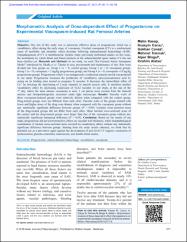Morphometric analysis of dose-dependent effect of progesterone on experimental vasospasm-induced rat femoral arteries
Künye
Kasap, M., Canaz, H., Canaz, G., Tokmak, M., Bingül, A. ve Alataş, İ. (2018). Morphometric analysis of dose-dependent effect of progesterone on experimental vasospasm-induced rat femoral arteries. Asian Journal of Neurosurgery, 13(2), 271-276. https://dx.doi.org/10.4103/1793-5482.228567Özet
Objective: Our aim of this study was to determine effective doses of progesterone which has a vasodilatory effect during the early stage of vasospasm. Cerebral vasospasm (CV) is a predominant cause of morbidity and mortality which develops following subarachnoidal hemorrhage (SAH). Etiopathogenesis of CV is multifactorial. Despite many previously performed studies on this issue, the mechanism by which blood and blood products in the subarachnoidal space induce CV has not been clarified yet.Materials and methods: In our study, we used "Rat Femoral Artery Vasospasm Model" introduced by Okada et al. Thanks to easy procurement and maintenance of rats. Rats were divided into four groups as: Group 1 (n = 8; control group), Group 2 (n = 8; vasospasm group), Group 3 (n = 8; vasospasm + 3 mg/kg progesterone group), and Group 4 (n = 8; vasospasm +15 mg/kg progesterone group). Progesterone which is an endogenously synthesized natural steroid was preferred in our study. Progesterone increases the production of vasodilatory epoxyeicosatrienoic acid by acting on its binding sites termed as pregnane X receptor. It decreases the intracellular influx of Ca2+ by blocking the functioning of L-type channels in smooth muscle cells. It manifests another vasodilatory effect by decreasing expression of TxA2 receptor. In our study, at the end of the 7th day, where the most intense vasospasm is seen, 1 cm pieces were excised from the femoral arteries and histopathologically examined under light microscope.Results: Vascular walls of three vasospasm-induced groups were relatively thicker when compared with the control group. Drug-treated groups were not different from each other. Vascular walls of the groups treated with lower and higher doses of the drug were thinner when compared with the vasospasm group without any statistically significant difference between groups (P > 0.05). Luminal cross-sectional areas of the drug-treated groups did not differ from each other. Mean luminal cross-sectional areas of the control and the drug-treated groups were larger than that of the vasospasm group without any statistically significant intergroup difference (P > 0.05).Conclusion: Based on the results of our study, progesterone did not exert protective effects on vascular wall thickness, while histopathological examination of luminal cross-sectional areas revealed its vasodilatory effects without any statistically significant difference between groups. Starting from the study results obtained, we think that its potential use as a preventive agent against the development of post-SAH CV requires conduction of multicentered, placebo-controlled, randomized, and double-blind studies.
Kaynak
Asian Journal of NeurosurgeryCilt
13Sayı
2Koleksiyonlar
- Makale Koleksiyonu [3752]
- PubMed İndeksli Yayınlar Koleksiyonu [4204]


















